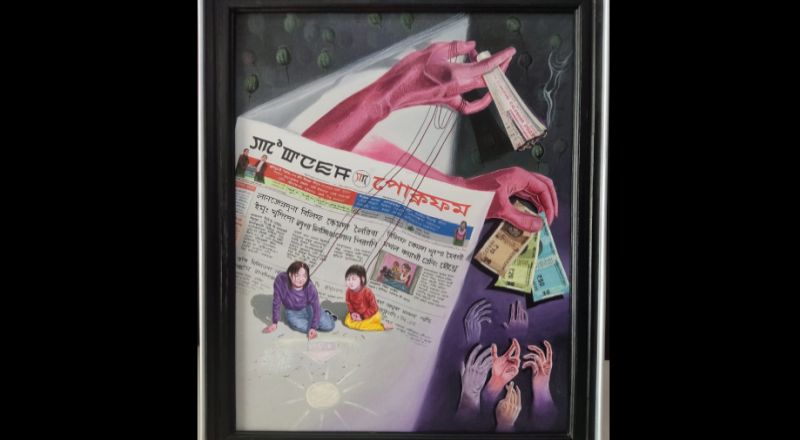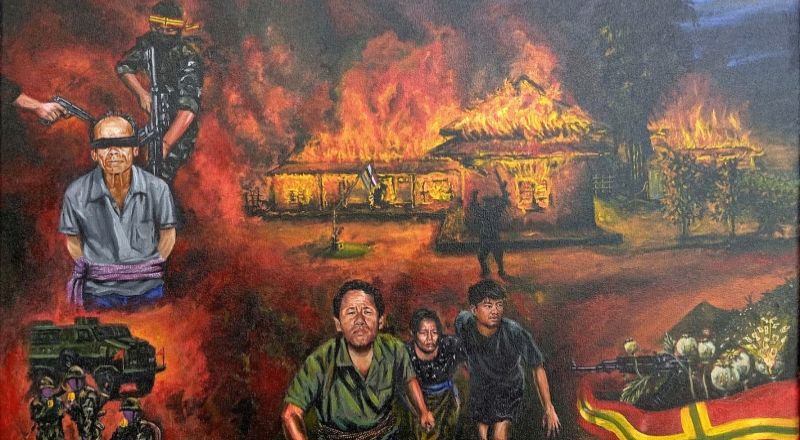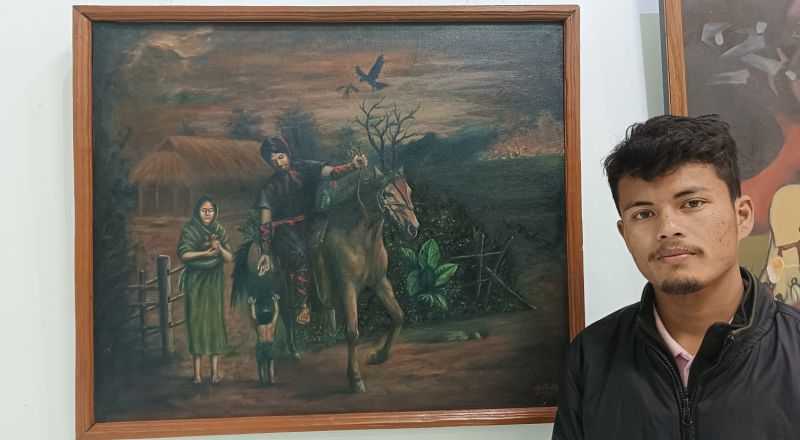It was a windy February evening in Imphal as Laishom Rituchandra, an artist displaced by the conflict in Manipur, nervously waited at the State Art Gallery, Palace Compound, Imphal for the 10th Maharajkumar Priyabrata Singh Memorial Art Exhibition, 2024 to begin.
The much-hyped exhibition is one of the go-to art events for artists, art enthusiasts and art lovers in general. Annual art exhibitions are a rare event in Manipur with very few exhibition galleries and even fewer exhibition events. Contemporary artists in Manipur do not have a mass following while appreciation for artwork is yet to establish a proper foothold.
The open group exhibition is a four-day annual event organised in memory of (late) MK Priyabrata Singh, an avid painter, who served as the chief minister and is often regarded as one of the leading figures of post-colonial Manipur.
Artists and art enthusiasts from various corners began flocking to the gallery to gaze upon the majestic artworks of 48 artists from various art backgrounds. Altogether 60 artworks, including sculptures and paintings were being displayed during the entire exhibition.
However, the exhibition also in-stored the peculiar artworks of two struggling displaced artists.
In an inspiring story of triumph and resilience, Laishom Rituchandra and Athokpam Maipaksana used their art to reflect the horrors and terrible fate that befell them after the eruption of the unrest which erupted on May 3, 2023.
But now, the inkling of financial turmoil, mental distress and fear of restarting their lives from zero has seeped into their artistic lives which are riding on sheer hope and determination to pursue their passion.
Testimony and paintings
“My zeal to continue painting is flickering. The burden of financial strains and the well-being of my family have taken top priority over painting at the moment,” said Laishom Rituchandra.
Laishom Rituchandra, 30, is a 3rd semester Visual Arts student at the Manipur University of Culture. He originally hails from Uyung Lawai, commonly known as Motbung in Kangpokpi district.
He and his family narrowly escaped the violence which erupted on the fateful day at Motbung and since then, have been seeking refuge at various relief camps. He is a young father and a family man who now stays at Lamboi Khongnangkhong Relief Camp, Imphal along with his parents.
Since the crisis, Rituchandra’s artistic theme which usually centred on peace and communal harmony has dramatically shifted towards - a darker, more expressive and more outspoken portrayal.
He started a series of paintings inspired by the crisis and showcased his fourth entry into the collection titled ‘Unheard Cries 3’ at the 10th Maharajkumar Priyabrata Singh Memorial Art Exhibition. His second painting in the series titled ‘Puppetry’, an acrylic medium painting, was displayed at the prestigious 29th Group Art Exhibition of Manipur State Kala Akademi at Santiniketan, West Bengal held recently.
 (PHOTO: IFP)
(PHOTO: IFP)
His painting collection retells the horrors of his near-death experience; explores the underlying tone of the conflict and primarily encapsulates the mental whirlwind that he is bracing as a displaced visual artist staying in a relief camp.
Rituchandra utilizes unorthodox vibrant colours with deep tones, peculiar imagery and his unique artistic perception to convey a widely felt sentimental notion.
But apart from artistic prowess, Rituchandra highlighted that his thinking and imagination had been greatly impeded by fear of financial, social and physical well-being for his family.
“I do not know what the future holds. But for now, my interest in painting is dying; the embers will stay alive but I have far more important matters in mind which need to be addressed,” he said.
He stated that he wanted to move out of the confines of the relief camp and stay in a rented house but could not as he had very limited means at the moment and had to look out for his family.
“I will move out eventually. I have to. The relief camp cannot shelter and feed us forever. I have taken a resolution to find any livelihood means and start providing for my family; otherwise, this will not work,” he said.
He highlighted that he was unable to focus and complete any academic assignments prescribed in his VA course at the MUC.
However, he maintained that he would try to paint during his leisure time while looking for other opportunities to usher economic relief for his family.
Twenty-five-year-old Athokpam Maipaksana, another displaced artist, also narrated a similar tale as we spoke outside the exhibition hall at Manipur University of Culture.
“I have just started to take on responsibilities as a newly married man and the crisis happened. My entire plan to slowly soak in my artistic passion has greatly been affected as, now, I have to figure out a livelihood means to sustain myself and my family,” he said.
Maipaksana is a final year Bachelor of Fine Art (B.F.A) student at Imphal Art College and originally hails from Serou, Kakching district. He stayed for a while at a relief camp in Langmeidong but shifted to Phaknung, Imphal East to attend college and search for job opportunities.
His sweet smile and humble demeanour also hid the tragic tale and trauma of the crisis. Maipaksana told us that he and his family, fortunately, escaped the invasion of the militants during the eruption of the crisis at Serou, but “helplessly watched” as their ancestral home was ransacked and burnt in the backdrop.
However, Maipaksana’s 72-year-old paternal uncle Athokpam Muhindro was unluckily captured and mercilessly executed by suspected Kuki militants as the entire violent ordeal unfolded at Sugnu-Serou region.
 (PHOTO: IFP)
(PHOTO: IFP)
Athokpam Maipaksana’s acrylic medium painting ‘Meichak’, painted on a 20x30 canvas, captures this horrific encounter he and his family endured when the crisis erupted. The painting narrates the entire incident – from the execution of his uncle to the burning of his house.
On a more serious note, the deep resentment for central forces is also etched in his painting. According to him, the central forces stationed at Serou simply “stood by” and “drank tea” while the militants “freely” torched the houses in Serou.
For the 10th Maharajkumar Priyabrata Singh Memorial Art Exhibition, Maipaksana presented his second artwork inspired by the conflict titled ‘Laman‘, an oil-based painting. The artwork slightly strays away from the contemporary issue and keeps it as an undertone by drawing inspiration from the past.
Maipaksana’s artistic niche mainly focuses on historical painting which showcases the rich diverse culture of Manipur. He emphasizes and abundantly uses deep dark colours to push forward an underscored theme and emotion.
But Maipaksana, similar to Rituchandra, is also reeling under immense financial constraints and struggling to keep afloat as an artist.
“Everyone needs money to survive; plain and simple. But what is even more important is to be treated as human beings. We were driven out of our homes penniless and now my family is scattered all over. We want to feel whole, we want to feel at home,” he said.
He highlighted that even his parents who had retired from their rural professions had started working to earn daily wages and keep the family afloat.
Both artists come from humble backgrounds and curated their passion from an early age. They stated that they dreamt of becoming true professionals in their field and passing on whatever they had learnt to the next generation of artists.
With wavering financial status and the ceaseless turmoil in the backdrop, both artists have been driven to the point that they are unable to afford even their paintbrush and colours. Both highlighted that they were able to “sustain themselves” before the crisis by taking on “commercial requisition” for paintings but now, even that has been cut.
“We used to get purchase orders before but at the relief camp all our contacts are lost while the conflict has also halted all commercial activities,” said Rituchandra.
As such, both maintained that their artistic passions had taken a back seat in their pursuit to provide their families with a better life.
 (PHOTO: IFP)
(PHOTO: IFP)
Explanations and more
During an interaction with the Imphal Free Press, Director of Arts and Culture, Manipur K Dinamani highlighted that there were no specific measures implemented at the moment to aid the displaced artists, especially the visual artists.
“However, the department has discussed putting together a one-time special package for Shumang Leela artiste by the start of the new budget year in April-May,” he said.
He also stated that discussions about providing aid to artists of other genres were also in the pipeline.
“We will mete out necessary steps- whether it is a survey or other aids when the annual budget of the department is sanctioned in the coming months,” he said.
He further noted that the department had timely assisted in providing free admissions to displaced individuals who wanted to study in government music and art colleges.
“We extended the assistance only when the displaced individuals informed us personally. No survey was conducted for the measure,” he said.
He also highlighted the benefits of ‘Chief Minister Artist Singgi Tengbang’ but noted that there were no special provisions- be it financial or any form of assistance, for displaced artists/artiste at the moment.
As the conversation drew to a close, the director and deputy director who was also in the room assured Imphal Free Press that the department would be more than willing to help displaced artists/artiste if proper information and details were provided.
“We ask the media persons and journalists to inform the department about such artist/artistes so that the department could organise a meeting, listen to their grievances and map out ways to work collectively,” the deputy director added.
Meanwhile, the assistant professor of the Department of Fine Arts, Manipur University, Moirangthem Monali advised the displaced artists to use their art as therapeutic means by imparting them to others who share the same trauma and experience of the turmoil.
“The government should also explore this area. The measure will require assistance which can only be provided by the authorities. This can potentially start a movement of using ‘art as therapy’ and relieve the displaced people especially the children during these troubled times,” she said.
As the Imphal Free Press shared the story about the displaced visual artists, the professor lamented over their desperate condition and emphasised the need for the visual art community in Manipur to unite and extend appropriate aids to such people.
“We may not be able to resolve all their grievances but will be able to understand their needs much better. Meanwhile, the authorities also need to figure out ample measures to help them,” she said.
Slogans of disappointment
Both Rituchandra and Maipaksana questioned if the authorities had simply forgotten about the thousands stranded in various relief camps.
They also asked if the authorities were serious about resolving the prolonged crisis and added if their vested interests had overridden the cries and suffering of the people.
“How long are we going to stay like this? We want to settle down and lead quiet happy lives with our families. We are starting to feel if we have been kept for their political theatrics,” said Rituchandra.
Maipkasana stated that fighting it out would not end the conflict but rather lead to more violence and enmity. Ultimately it is the government’s responsibility to resolve the crisis through political maneuvers, he added.
Rituchandra maintained that security and affirmative actions were the crucial need of the hour. “We want to go home. We cannot live out our lives at the relief camp. The feeling is shared by thousands who stay in relief camps,” he said.
General opinion
Over 60,000 people have been displaced as a result of the crisis with crores of state and personal properties destroyed.
Meanwhile, reports of shootouts have not escaped a day without a mention in the local news. What is even more alarming is the reportage of “sophisticated war weapons” being introduced into the whole mix.
At this crucial juncture, people are extremely worried about the future of Manipur on all fronts - be it social, economic and of course, political.
Rishikesh Naorem, a student and part-time news anchor at a local channel has expressed deep concern over authorities’ failure to grab a hold of the menacing conflict which unfolded in the last ten months.
“What is even more concerning is that the government seems unhinged by the crisis. The conflict has revealed the loopholes in the system, which by now, they should have rectified,” he said.
He questioned if the authorities had any blueprint to resolve the mammoth turmoil.
“They have failed to assess the conflict in its entirety. The ability to predict certain outcomes and prepare for it has been one of the key commandments of any political system which in this case, is lagging,” he said.
Meanwhile, Beatle Yambem, a 5th-semester graduate student, expressed concern over the future of students and the academic sector in general.
“Simply adhering to the annual academic routine will not keep the education sector devoid of conflict. What is even more important is the suitable academic environment,” he said.
He continued that thousands of displaced students are still unable to attend schools and colleges because of the traumas they endured.
“How can they study when they are worried about their uncertain future? Or for that matter, how can any relief camp inmate live in peace when their whole lives have been destroyed?” he asked.
He pointed out that fear of economic instability was the major concern for all displaced inmates.
“It is not easy to adjust, adapt and find work in a new environment. The government needs to realise that and resolve the conflict for the sake of the displaced children and families,” he added.
What would happen to the culture and arts of Manipur if all artists/artiste ceased their practice during the prolonged conflict remains an intimidating question. They both assured that they would not give up their practice but who can be certain of the future?